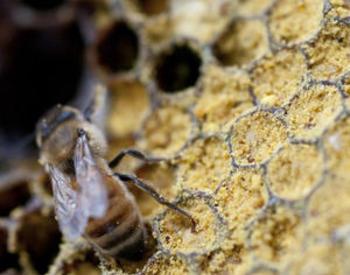Mouthparts are fascinating parts of bee anatomy, but like mouths of insects in general, they can be difficult to understand (see Gary Larson cartoon).
Mouthparts are easy to ignore because we don’t understand much about them. The goal of this essay is to familiarize you with the parts, how they function, what they do and why some are different.
This segment will focus on two kinds of short-tongued bees that demonstrate these features. It will be followed by the more complex long-tongued ones in a separate entry. Ignore the confusing fact that some short-tongued bees have long tongues, and some long-tongued bees have short tongues. Hopefully, having a greater grasp of the subject will increase your curiosity and reward your interpretations.
Most bees have a tongue that is pointed or has a tip like a tiny spoon. In the photo of this colletid bee, you will see most of the typical features of short-tongued bees with the exception of a bilobed or bifid tongue. Unlike most bees, they use this specialized tip to paint a cellophane-like material as a lining for their brood cells.
Two visualizations of the cross-sections of the mouthparts of long- and short-tongued bees can be made with your hands. For long-tongued bees make an oblong circle by taking your index and middle fingers of each hand and putting the tips together, and then put your thumb tips together. You should be looking at an igloo-shaped oval. The joined fingers of each hand are like the upper quarters of the long tube that surrounds the tongue. Your thumbs represent several palps that together form the underside of the tube. If this visualization doesn’t seem convincing, stick your tongue way out and put it in the center of the form.
Short-tongued-bees are different. They have only the top half or two quarters of the roof. The photo shows the two sections. Each half is called a galea, and sometimes the two overlap to look like a beak. If you release the tips of your thumbs and then press your thumbs against the edges of your hands, the structure will look more like the short-tongued bee in the photograph.
Other easy-to-see features in the image are the two pairs of palps. They are important sensory devices necessary for tasting and touching. The upper pair consists of maxillary palps and the lower pair of labial palps. It is the lower palps that have gone through extraordinary modifications in long-tongued bees.
The generic bee tongue is densely covered by small projections called papillae. The tip of the tongue in some species can lap nectar like a cat drinks water. The papillae are close enough to each other that capillary action draws the nectar up the tongue to the prementum, a structure that attaches to the labial palps and the tongue. From there, the nectar can be sucked upwards into the mouth. Some short-tongued mining bees can pull the prementum and tongue up and down to create an efficient pumping system.
The first primitive flowers were shallow and offered easy access to pollen and nectar rewards for insects and others. Over eons of time, flowering plants evolved deeper and less accessible nectaries. Bees were coaxed deep into the flowers to ensure a better transfer of pollen for the plants. Selection favored modifications of mouthparts into longer and more complex structures.
A great example is shown in the two images of the short-tongued Agapostemon, a sweat bee. To extend its reach, two hinges are involved. The cardo, a structure that is hinged to the head, has elongated over time. The hinged segment below that, the stipes, with the prementum inside, gives support and protection for the tongue. With this arrangement the mechanism can double in length, and then conveniently fold back together and slip into a groove under the head. The images show the moveable parts and the pocket they retract into. This genus is in a group of short-tongued bees, so you can appreciate the concept that the name of the group is not necessarily a predictor of tongue length.
The Apidae and Megachilidae are long-tongued bees. They are much more complicated due to more refined mechanisms. It could be beneficial to spend a little time looking at the names on the diagram. The one on the right is for short-tongued bees and the left one is for long-tongued bees. Many of the terms for the two groups are the same, so if you review the words in the diagram, you will better understand the anatomy and function of these fascinating creatures as you learn more later.



















